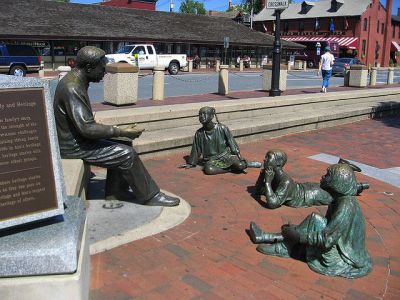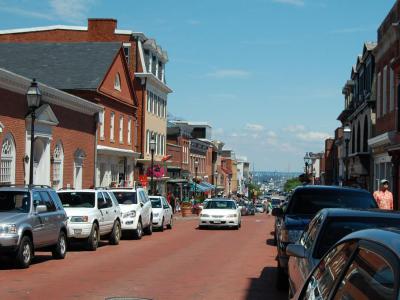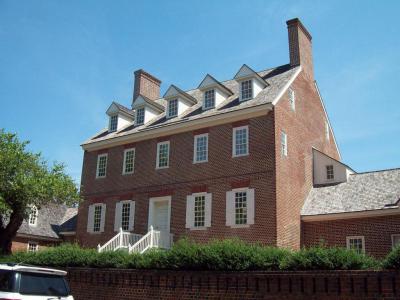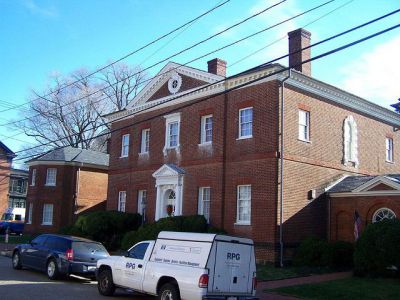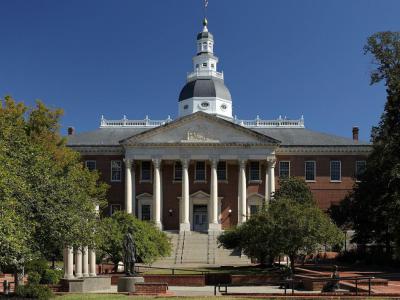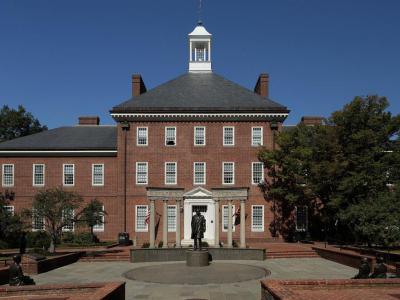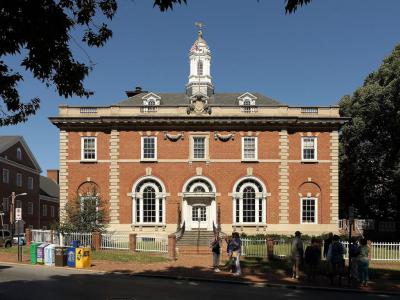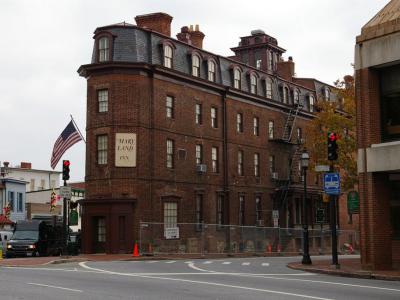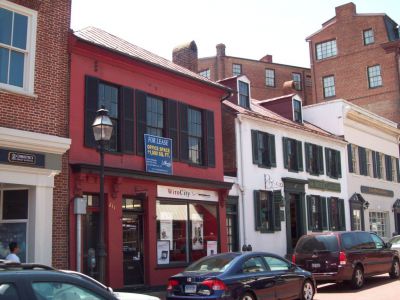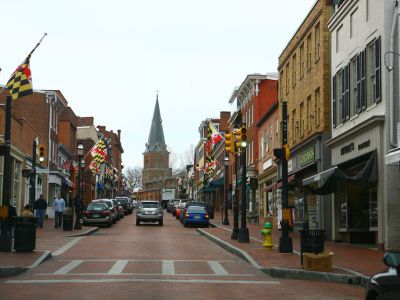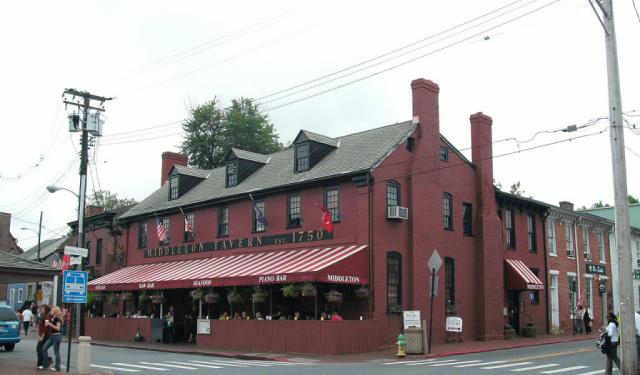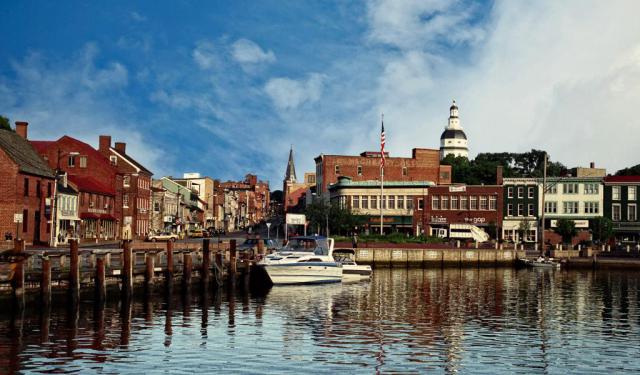
Annapolis Introduction Walking Tour (Self Guided), Annapolis
Nestled along the banks of the Severn River flowing into the Chesapeake Bay on the East Coast of the United States is the capital of the US state of Maryland, Annapolis. Dubbed “America’s Sailing Capital”, Annapolis thrives on its nautical roots and colonial history, boasting more 18th-century buildings still in use than any other city in the country.
Annapolis traces its origins back to 1649 when Puritan exiles from Virginia settled in the area and named it "Providence" after their safe arrival. However, in 1694, the settlement was renamed Annapolis (“Anna's city”) in honor of Princess Anne of Denmark, who would later become Queen Anne of Great Britain.
Over the years, Annapolis grew rapidly, serving as a political capital and a major center of the Atlantic slave trade until the American Revolutionary War. In 1783, after the Treaty of Paris, it briefly served as the temporary capital of the United States. The city's significance in American history was further solidified with the Annapolis Convention in 1786, which led to the drafting of the United States Constitution.
Throughout the Civil War, Annapolis was a major location for housing paroled soldiers across three camps, the last of which led to the creation of Parole, now known as home to the Annapolis National Cemetery. During World War II and later – during the Korean and Vietnam wars, Annapolis shipyards constructed military vessels.
One of Annapolis's most poignant landmarks is the Kunta Kinte - Alex Haley Memorial, paying tribute to the resilience and legacy of African Americans. Visitors can also explore the Banneker-Douglass Museum, dedicated to African American heritage and culture.
Ego Alley, a bustling waterfront strip, showcases the city's vibrant maritime scene, dotted with sailboats and yachts.
History buffs will find delight in the William Paca House and Garden, a meticulously preserved 18th-century mansion offering a glimpse into colonial life. The Maryland State House and Government House further underscore Annapolis's significance in American history.
Annapolis's architectural splendor shines through landmarks like Saint Anne's Church, Maryland Inn, Old City Hall, and Engine House. For a sweet treat, indulge in artisanal flavors at the Annapolis Ice Cream Company along charming Main Street.
With its cobblestone streets and waterfront views, Annapolis invites you to dive into its eventful past and vibrant atmosphere. From exploring historic districts to trying local cuisine, there's much to enjoy here. Just follow our self-guided walk and experience for yourself the allure and timeless appeal of this lovely city!
Annapolis traces its origins back to 1649 when Puritan exiles from Virginia settled in the area and named it "Providence" after their safe arrival. However, in 1694, the settlement was renamed Annapolis (“Anna's city”) in honor of Princess Anne of Denmark, who would later become Queen Anne of Great Britain.
Over the years, Annapolis grew rapidly, serving as a political capital and a major center of the Atlantic slave trade until the American Revolutionary War. In 1783, after the Treaty of Paris, it briefly served as the temporary capital of the United States. The city's significance in American history was further solidified with the Annapolis Convention in 1786, which led to the drafting of the United States Constitution.
Throughout the Civil War, Annapolis was a major location for housing paroled soldiers across three camps, the last of which led to the creation of Parole, now known as home to the Annapolis National Cemetery. During World War II and later – during the Korean and Vietnam wars, Annapolis shipyards constructed military vessels.
One of Annapolis's most poignant landmarks is the Kunta Kinte - Alex Haley Memorial, paying tribute to the resilience and legacy of African Americans. Visitors can also explore the Banneker-Douglass Museum, dedicated to African American heritage and culture.
Ego Alley, a bustling waterfront strip, showcases the city's vibrant maritime scene, dotted with sailboats and yachts.
History buffs will find delight in the William Paca House and Garden, a meticulously preserved 18th-century mansion offering a glimpse into colonial life. The Maryland State House and Government House further underscore Annapolis's significance in American history.
Annapolis's architectural splendor shines through landmarks like Saint Anne's Church, Maryland Inn, Old City Hall, and Engine House. For a sweet treat, indulge in artisanal flavors at the Annapolis Ice Cream Company along charming Main Street.
With its cobblestone streets and waterfront views, Annapolis invites you to dive into its eventful past and vibrant atmosphere. From exploring historic districts to trying local cuisine, there's much to enjoy here. Just follow our self-guided walk and experience for yourself the allure and timeless appeal of this lovely city!
How it works: Download the app "GPSmyCity: Walks in 1K+ Cities" from Apple App Store or Google Play Store to your mobile phone or tablet. The app turns your mobile device into a personal tour guide and its built-in GPS navigation functions guide you from one tour stop to next. The app works offline, so no data plan is needed when traveling abroad.
Annapolis Introduction Walking Tour Map
Guide Name: Annapolis Introduction Walking Tour
Guide Location: USA » Annapolis (See other walking tours in Annapolis)
Guide Type: Self-guided Walking Tour (Sightseeing)
# of Attractions: 15
Tour Duration: 2 Hour(s)
Travel Distance: 2.2 Km or 1.4 Miles
Author: Caroline
Sight(s) Featured in This Guide:
Guide Location: USA » Annapolis (See other walking tours in Annapolis)
Guide Type: Self-guided Walking Tour (Sightseeing)
# of Attractions: 15
Tour Duration: 2 Hour(s)
Travel Distance: 2.2 Km or 1.4 Miles
Author: Caroline
Sight(s) Featured in This Guide:
- Kunta Kinte - Alex Haley Memorial
- Ego Alley
- Middleton Tavern
- William Paca House and Garden
- Hammond-Harwood House
- Maryland State House
- Government House
- Thurgood Marshall Memorial
- Annapolis Post Office
- St. Anne's Church
- Banneker-Douglass Museum
- Maryland Inn
- Old City Hall and Engine House
- Annapolis Ice Cream Company
- Main Street
1) Kunta Kinte - Alex Haley Memorial (must see)
Located at the head of the Annapolis harbor, beside the City Dock, the Kunta Kinte-Alex Haley Memorial is the only memorial in the United States commemorating the actual name and place of landing of an enslaved African in the New World. The monument was inspired by Alex Haley’s 1976 Pulitzer Prize-winning novel, “Roots: The Saga of an American Family”, which tells the story of his ancestor, Kunta Kinte, an 18th-century African boy from the Gambian town of Jufferee, who was sold into slavery and transported in chains to the United States. The memorial marks the very spot where Kunta Kinte set foot on American soil, and is dedicated to all of African Americans' ancestors whose names are lost forever in the oceans of time.
The memorial comprises three distinct areas: the Alex Haley sculpture group, the Compass Rose, and the Story Wall. The former depicts Haley himself, reading from a book on his lap to three children of different races sitting in front of him. The nearby Compass Rose is made of granite and measures 14 feet in diameter; it includes a bronze inlaid compass and the world map oriented to true North, with Annapolis at its center. The third piece, lining the retaining sea wall on Compromise Street, is the Story Wall. It represents a series of ten markers topped with bronze plaques, each displaying a quote from Alex Haley’s book. Each quote is accompanied by text and unique graphics to explain its meaning.
The “A Luta Continua” (Portuguese: “the struggle continues”) slogan refers to the 23 years of challenges that took to erect this memorial, from 1979, when Alex Haley’s best selling story prompted discussions of its placing, to June 12, 2002, when the final phase of the Kunta Kinte-Alex Haley Memorial was dedicated. In 1981, the first commemorative plaque installed on the site was stolen within just 48 hours, allegedly by the Ku Klux Klan! The news of the theft made international headlines, but the plaque was never recovered. Two months later, citizens of Annapolis had raised funds and replaced it.
Today, the memorial is seen by almost 1,000,000 visitors a year. Sadly, Alex Haley himself did not live to see it completed.
The memorial comprises three distinct areas: the Alex Haley sculpture group, the Compass Rose, and the Story Wall. The former depicts Haley himself, reading from a book on his lap to three children of different races sitting in front of him. The nearby Compass Rose is made of granite and measures 14 feet in diameter; it includes a bronze inlaid compass and the world map oriented to true North, with Annapolis at its center. The third piece, lining the retaining sea wall on Compromise Street, is the Story Wall. It represents a series of ten markers topped with bronze plaques, each displaying a quote from Alex Haley’s book. Each quote is accompanied by text and unique graphics to explain its meaning.
The “A Luta Continua” (Portuguese: “the struggle continues”) slogan refers to the 23 years of challenges that took to erect this memorial, from 1979, when Alex Haley’s best selling story prompted discussions of its placing, to June 12, 2002, when the final phase of the Kunta Kinte-Alex Haley Memorial was dedicated. In 1981, the first commemorative plaque installed on the site was stolen within just 48 hours, allegedly by the Ku Klux Klan! The news of the theft made international headlines, but the plaque was never recovered. Two months later, citizens of Annapolis had raised funds and replaced it.
Today, the memorial is seen by almost 1,000,000 visitors a year. Sadly, Alex Haley himself did not live to see it completed.
2) Ego Alley (must see)
Ego Alley (Annapolis City Dock) is not an alley in the traditional sense of the word; rather than a walkway, it represents a small, narrow waterway that leads to the heart of Annapolis and spills out into Spa Creek. The name "ego alley" derives from the endless queue of expensive yachts parading through this dead-end canal, usually only to see and be seen, on evenings and weekends. Considering this is where all the boats must turn around, it is a great place to see them. Sometimes it can be quite fun too, since not all skippers are skillful enough to operate their vessels in such tight and crowded conditions. Other than ship-watching, this scenic marina also makes for an interesting place to meander, shop, and dine.
On one side, it has the Marriott Waterfront Hotel, complete with their famous "Pusser's Restaurant and Bar", whose outdoor tables are literally inches away from the water and provide an ideal vantage point. Close-by, on the same side, is a yacht club, a marine store, and then a concrete half wall that allows people to have a seat and take in the scenery. On the opposite side of Ego Alley, there are boat slips and several water taxi stands. The wall continues here as well, but the many docking boats often block the view. At the end of the canal is the dinghy dock where the visiting seafaring folks, who are either moored or anchored out in the harbor, take their smaller vessels into town for provisions, sightseeing, etc.
During winter holiday season, albeit cold, is yet another good time to take a stroll down here, since many of the boats are decked out in Christmas lights. There are just as many benches here as well, with many people enjoying their ice cream or some other edible delight from one of the local shops. You can regularly see Naval Academy midshipmen here in uniform on the weekend, coming down to relax and with visiting friends. Also on weekends, you can expect to hear various free musical performances from locals, such as the band Little Bird.
On one side, it has the Marriott Waterfront Hotel, complete with their famous "Pusser's Restaurant and Bar", whose outdoor tables are literally inches away from the water and provide an ideal vantage point. Close-by, on the same side, is a yacht club, a marine store, and then a concrete half wall that allows people to have a seat and take in the scenery. On the opposite side of Ego Alley, there are boat slips and several water taxi stands. The wall continues here as well, but the many docking boats often block the view. At the end of the canal is the dinghy dock where the visiting seafaring folks, who are either moored or anchored out in the harbor, take their smaller vessels into town for provisions, sightseeing, etc.
During winter holiday season, albeit cold, is yet another good time to take a stroll down here, since many of the boats are decked out in Christmas lights. There are just as many benches here as well, with many people enjoying their ice cream or some other edible delight from one of the local shops. You can regularly see Naval Academy midshipmen here in uniform on the weekend, coming down to relax and with visiting friends. Also on weekends, you can expect to hear various free musical performances from locals, such as the band Little Bird.
3) Middleton Tavern
Located in Downtown’s City Dock, just a block from the United States Naval Academy, Middleton Tavern is a testament to both of these local story lines. Established in 1750 by Horatio Middleton, this is one of the oldest continuously operating taverns in America. It started off as an “inn for seafaring men”, providing base for Middleton’s Ferry Service which linked Annapolis to Maryland’s Eastern Shore, and thus served as the meeting site for many historic personalities.
Tench Tilghman took the ferry to deliver news of Cornwallis’ surrender in 1781, while Thomas Jefferson used it en route to Rock Hall in 1783, whereas George Washington took it on his way to…somewhere, too. After Middleton’s death, his son expanded the family business to include ship building and overseas trade. During that time, the tavern enjoyed some of its most sensational customers. Practically next door to the Maryland State House, members of the Continental Congress came to this joint after the ratification of the Treaty of Paris and the official end of the Revolutionary War in January 1784.
James Monroe, a friend of the elder Middleton, may have even visited the tavern in 1818 as a sitting president. The bar’s history throughout the rest of the 1800s is a little hazy, but in 1968, the current owner, Jerry Hardesty, bought and restored the property. In 1983, he expanded the restaurant to include the new Tavern and Oyster Bar.
Void of the surrounding gardens, which, back in the old days, stretched from Prince George Street to the water, Middleton’s front porch today provides some of the greatest people watching in town. Paired with some fresh regional seafood from the raw bar and a Category 3 Dark and Stormy, it creates recipe for a fantastic evening in Annapolis. The tavern's specialties include Maryland crab cakes, rockfish, oysters, and clams. Middleton’s Electric Lemonade (Smirnoff Citrus Vodka and Blue Curaçao mixed with the Tavern’s homemade lemonade) is a separate attraction.
Other than the great food and drink served with a slice of history, this 18th-century Georgian establishment also hosts some truly magnificent live music events: acoustic blues, piano, jazz and anything else to make you feel great. Their famous Piano Bar on Friday and Saturday nights are particularly not to be missed!
Tench Tilghman took the ferry to deliver news of Cornwallis’ surrender in 1781, while Thomas Jefferson used it en route to Rock Hall in 1783, whereas George Washington took it on his way to…somewhere, too. After Middleton’s death, his son expanded the family business to include ship building and overseas trade. During that time, the tavern enjoyed some of its most sensational customers. Practically next door to the Maryland State House, members of the Continental Congress came to this joint after the ratification of the Treaty of Paris and the official end of the Revolutionary War in January 1784.
James Monroe, a friend of the elder Middleton, may have even visited the tavern in 1818 as a sitting president. The bar’s history throughout the rest of the 1800s is a little hazy, but in 1968, the current owner, Jerry Hardesty, bought and restored the property. In 1983, he expanded the restaurant to include the new Tavern and Oyster Bar.
Void of the surrounding gardens, which, back in the old days, stretched from Prince George Street to the water, Middleton’s front porch today provides some of the greatest people watching in town. Paired with some fresh regional seafood from the raw bar and a Category 3 Dark and Stormy, it creates recipe for a fantastic evening in Annapolis. The tavern's specialties include Maryland crab cakes, rockfish, oysters, and clams. Middleton’s Electric Lemonade (Smirnoff Citrus Vodka and Blue Curaçao mixed with the Tavern’s homemade lemonade) is a separate attraction.
Other than the great food and drink served with a slice of history, this 18th-century Georgian establishment also hosts some truly magnificent live music events: acoustic blues, piano, jazz and anything else to make you feel great. Their famous Piano Bar on Friday and Saturday nights are particularly not to be missed!
4) William Paca House and Garden (must see)
The William Paca House (once known as Carvel Hall) is an 18th-century landmark comprising a five-part Georgian-style mansion and the terraced pleasure garden, both built between 1763 and 1765 to the design by William Paca, a patriot leader who was one of Maryland’s four Signers of the Declaration of Independence in 1776 and the state’s third Governor, serving from 1782 to 1785.
The brickwork structure comprises a central two-and-a-half-story block on an elevated platform, flanked by symmetrical one-and-a-half-story end pavilions, connected to the central structure by one-and-a-half-story hyphens. The building's beautiful interior boasts original woodwork remaining in the central hall, stair hall and the west parlor, including the stair's original Chinese Chippendale balustrade and other decorations relevant to the Georgian Era style. The two-acre (8,100 m2) walled garden, which includes a two-story summer house, represents precise geometric parterres of three-season blooming flowers.
The Paca family resided in the mansion along with their servants and slaves until 1780. After William Paca sold the house, it continued as a single-family home until 1801, upon which it served mainly as a rental property for much of the 19th century. National tennis champion William Larned bought the property in 1901 and converted it into a hotel, with a large addition attached to the back and extending over most of the old garden. For much of the 20th century, Carvel Hall was Annapolis’s finest hotel.
Concerned that developers might eventually tear down the historic edifice, Historic Annapolis and the State of Maryland bought the Paca mansion and the rest of the Carvel Hall site in 1965. Beginning the same year and over the next decade, a team of experts had painstakingly restored the house and the garden to their original 18th-century splendor using details drawn from historic artwork and archaeological excavations.
Today, this picturesque retreat from the bustle of the city, replete with period furnishings and paintings, reveals the inner workings of an upper-class household in colonial and revolutionary Annapolis. In 1971, the mansion was declared a National Historic Landmark.
Both, the house and the garden are open for guided tours Monday to Saturday, from 10 am to 5 pm, and Sundays, from 10 am to 5 pm (last tour at 3.30 pm).
The brickwork structure comprises a central two-and-a-half-story block on an elevated platform, flanked by symmetrical one-and-a-half-story end pavilions, connected to the central structure by one-and-a-half-story hyphens. The building's beautiful interior boasts original woodwork remaining in the central hall, stair hall and the west parlor, including the stair's original Chinese Chippendale balustrade and other decorations relevant to the Georgian Era style. The two-acre (8,100 m2) walled garden, which includes a two-story summer house, represents precise geometric parterres of three-season blooming flowers.
The Paca family resided in the mansion along with their servants and slaves until 1780. After William Paca sold the house, it continued as a single-family home until 1801, upon which it served mainly as a rental property for much of the 19th century. National tennis champion William Larned bought the property in 1901 and converted it into a hotel, with a large addition attached to the back and extending over most of the old garden. For much of the 20th century, Carvel Hall was Annapolis’s finest hotel.
Concerned that developers might eventually tear down the historic edifice, Historic Annapolis and the State of Maryland bought the Paca mansion and the rest of the Carvel Hall site in 1965. Beginning the same year and over the next decade, a team of experts had painstakingly restored the house and the garden to their original 18th-century splendor using details drawn from historic artwork and archaeological excavations.
Today, this picturesque retreat from the bustle of the city, replete with period furnishings and paintings, reveals the inner workings of an upper-class household in colonial and revolutionary Annapolis. In 1971, the mansion was declared a National Historic Landmark.
Both, the house and the garden are open for guided tours Monday to Saturday, from 10 am to 5 pm, and Sundays, from 10 am to 5 pm (last tour at 3.30 pm).
Sight description based on Wikipedia.
5) Hammond-Harwood House
The Hammond-Harwood House is one of the premier and, arguably, the most exquisite property remaining in the United States from the British Colonial period (1607–1776). The house was designed by architect William Buckland in 1773-74. It ranks architecturally with many of the great mansions built in the late Colonial period, and is the only existing work of the Colonial academic architecture that was principally designed from a plate in Andrea Palladio’s I Quattro Libri dell’Architettura.
The Hammond-Harwood House is a five-part brick edifice with a five-bay two-story central block, two-story end wings and one-story connecting hyphens on either side. The central block has a shallow hipped roof. The wings project toward the street with three-sided hipped-roof bays. The hyphens are rendered as a blind arcade, with the central bay a door opening with a pediment above. There is little decoration, with plain rubbed brick flat arches over the windows. The interior presents the appearance of symmetry where it is in fact not symmetrical, using false doors where necessary to maintain the illusion.
The Hammond-Harwood House is a five-part brick edifice with a five-bay two-story central block, two-story end wings and one-story connecting hyphens on either side. The central block has a shallow hipped roof. The wings project toward the street with three-sided hipped-roof bays. The hyphens are rendered as a blind arcade, with the central bay a door opening with a pediment above. There is little decoration, with plain rubbed brick flat arches over the windows. The interior presents the appearance of symmetry where it is in fact not symmetrical, using false doors where necessary to maintain the illusion.
Sight description based on Wikipedia.
6) Maryland State House (must see)
The Maryland State House in Annapolis houses the Maryland General Assembly and offices of the Governor and Lieutenant Governor. It is the oldest state capitol in continuous legislative use, dating back to 1772. The two-story brick structure, in the middle of State Circle, was designed by Joseph Horatio Anderson, a noted architect of the time, in the popular Georgian style of that period.
A small portico juts out from the center of the building and is topped by a pediment; two high arched windows frame the entrance. The dome of the statehouse is depicted on the Maryland state quarter, and has the distinction of being topped by the largest wooden dome in the United States constructed without nails.
The current building, which was designated a National Historic Landmark in 1960, is the third statehouse on its site. Currently, the building is administered by the State House Trust, which was established in 1969.
A small portico juts out from the center of the building and is topped by a pediment; two high arched windows frame the entrance. The dome of the statehouse is depicted on the Maryland state quarter, and has the distinction of being topped by the largest wooden dome in the United States constructed without nails.
The current building, which was designated a National Historic Landmark in 1960, is the third statehouse on its site. Currently, the building is administered by the State House Trust, which was established in 1969.
Sight description based on Wikipedia.
7) Government House
Adjacent to the Maryland State House complex, the official residence of Maryland's Governor, the Government House, also known as the Governor's Mansion, was built in 1870 to the design of Baltimore architect R. Snowden Andrews (1830–1903). Originally designed in the fashion of the Victorian time, with a mansard roof and Italianate arched windows, the mansion was converted to its present Georgian-style country house appearance in 1935–36. More renovations, including cleaning, painting, and roof repairs were done in 1947, followed by a new skylight installed by Maryland craftsmen in 1987, and a fountain, featuring Maryland symbols, placed in the garden in 1990.
The building features seven public rooms: the Entrance Hall, Federal Reception Room, Victorian Library, Empire Parlor, Conservatory, State Dining Room and the Drawing Room. In the Entrance Hall there are portraits of Queen Henrietta Maria, after whom Maryland was named, painted in 1901 by Florence MacKubin, and of Charles Calvert, the Fifth Lord Baltimore. A portrait of Frederick Douglass, commissioned in 2014 and painted by Simmie Knox, is on display in the Drawing Room, along the portrait of George Washington painted during the Revolutionary War by Charles Willson’s Peale, one of America's foremost portrait painters.
The State Dining Room features the portrait of the Sharpe Family, painted in 1753 and attributed to Arthur Devis. A portrait bust of Harriet Tubman, displayed on a wooden pedestal made from wood of Maryland’s historic Wye Oak, is displayed in the Conservatory. Among other treasures attesting to Maryland's rich and glorious past found here are the furnishings by Potthast, the eminent Baltimore furniture makers of the 19th century. The Victorian library now recalls the original ambiance of Government House, and panels and roundels from those doors can be seen here as well.
Visitors to the house used to enter through magnificent walnut doors, carved with the Maryland coat of arms and symbols of Maryland industry and agriculture. The list of important guests to the state, received in this house since the founding of the colony in 1634, includes some illustrious individuals, like Mark Twain, Her Royal Highness Queen Elizabeth, the Queen Mother, and Sugar Ray Leonard.
The building features seven public rooms: the Entrance Hall, Federal Reception Room, Victorian Library, Empire Parlor, Conservatory, State Dining Room and the Drawing Room. In the Entrance Hall there are portraits of Queen Henrietta Maria, after whom Maryland was named, painted in 1901 by Florence MacKubin, and of Charles Calvert, the Fifth Lord Baltimore. A portrait of Frederick Douglass, commissioned in 2014 and painted by Simmie Knox, is on display in the Drawing Room, along the portrait of George Washington painted during the Revolutionary War by Charles Willson’s Peale, one of America's foremost portrait painters.
The State Dining Room features the portrait of the Sharpe Family, painted in 1753 and attributed to Arthur Devis. A portrait bust of Harriet Tubman, displayed on a wooden pedestal made from wood of Maryland’s historic Wye Oak, is displayed in the Conservatory. Among other treasures attesting to Maryland's rich and glorious past found here are the furnishings by Potthast, the eminent Baltimore furniture makers of the 19th century. The Victorian library now recalls the original ambiance of Government House, and panels and roundels from those doors can be seen here as well.
Visitors to the house used to enter through magnificent walnut doors, carved with the Maryland coat of arms and symbols of Maryland industry and agriculture. The list of important guests to the state, received in this house since the founding of the colony in 1634, includes some illustrious individuals, like Mark Twain, Her Royal Highness Queen Elizabeth, the Queen Mother, and Sugar Ray Leonard.
Sight description based on Wikipedia.
8) Thurgood Marshall Memorial
Standing proud outside the State House in Annapolis, the Thurgood Marshall Memorial was dedicated on October 22, 1996. The memorial commemorates the Baltimore-born, first African-American U.S. Supreme Court Justice, Thurgood Marshall, who served for 24 years and was one of the past century's foremost leaders in the struggle for equal rights under the law. Thurgood Marshall became famous in 1954 by bringing before the U.S. Supreme Court the case of Brown v. Board of Education of Topeka, which put an end to racial segregation in American public schools.
Following Marshall's death in 1993, the state of Maryland decided to honor his legacy. On May 17, 1994, exactly 40 years after the Supreme Court's Brown v. The Board of Education of Topeka decision, the governor of Maryland signed an Executive Order establishing the Thurgood Marshall Memorial Statue Commission. After a nationwide competition, the Commission awarded the memorial design to Maryland native artist Toby Mendez.
The winning design features an 8' statue of Thurgood Marshall as a young lawyer. Behind him are pillars with the inscription "Equal Justice Under Law", and facing him are two benches. On one of the benches is the figure of Donald Gaines Murray, whose entrance into the Law School of the University of Maryland marked Thurgood Marshall's first important victory in his struggle for school integration. On the other bench are the figures of two children representing Marshall's most important achievement, Brown v. The Board of Education of Topeka et. al. Within the circle of the plaza is a chronology of the important events in Thurgood Marshall's long and distinguished career.
The actual place of the memorial, on Lawyers' Mall, also known as State House Square, is particularly important, as it marks almost the exact spot where the Maryland Court of Appeals stood in the mid-1930s. In 1935, Marshall represented Donald Gaines Murray in a trial at that very court and won him and other black students the right to attend the University of Maryland School of Law. Many of the arguments Marshall used in winning that case were later used by him in Brown v. the Board of Education and other integration cases.
Following Marshall's death in 1993, the state of Maryland decided to honor his legacy. On May 17, 1994, exactly 40 years after the Supreme Court's Brown v. The Board of Education of Topeka decision, the governor of Maryland signed an Executive Order establishing the Thurgood Marshall Memorial Statue Commission. After a nationwide competition, the Commission awarded the memorial design to Maryland native artist Toby Mendez.
The winning design features an 8' statue of Thurgood Marshall as a young lawyer. Behind him are pillars with the inscription "Equal Justice Under Law", and facing him are two benches. On one of the benches is the figure of Donald Gaines Murray, whose entrance into the Law School of the University of Maryland marked Thurgood Marshall's first important victory in his struggle for school integration. On the other bench are the figures of two children representing Marshall's most important achievement, Brown v. The Board of Education of Topeka et. al. Within the circle of the plaza is a chronology of the important events in Thurgood Marshall's long and distinguished career.
The actual place of the memorial, on Lawyers' Mall, also known as State House Square, is particularly important, as it marks almost the exact spot where the Maryland Court of Appeals stood in the mid-1930s. In 1935, Marshall represented Donald Gaines Murray in a trial at that very court and won him and other black students the right to attend the University of Maryland School of Law. Many of the arguments Marshall used in winning that case were later used by him in Brown v. the Board of Education and other integration cases.
9) Annapolis Post Office
The Annapolis Post Office is an outstanding piece of public architecture, part of the Downtown state legislative compound encompassing nearly two million square feet of office space. Built in 1901, this dignified two-and-a-half–story edifice, laid in darkened English bond brick, features Georgian Revival style represented by the traditional three-parts facade with a three-bay central section. Topping the rectangular structure is a dormered hip roof surrounded by a balustrade.
Among other impressive embellishments gracing the building are a classical stone cornice, a neo-Palladian doorway and windows, the beautiful Wren-style octagonal cupola with gilded dome crowned by the carved golden pineapple symbolizing hospitality, and weather-vane, as well as Venetian windows with stately curved arches, and stone laurels draping like bunting from the brick facade. The building's interior is equally impressive and is rich in woodwork, especially oak paneling.
The Annapolis Post Office has a long history. Many local residents started and ended their careers here. Decades ago, the office upstairs was occupied by the FBI. Over the years, the "Post Office" has undergone several phases of renovation so as to accommodate some modern amenities. Still, the original style remains visible and makes it one of the most recognizable and historically important properties in Annapolis, showing that, back in the day, the government cared enough about architecture. William Morgan of Columbia University in New York City described the building in his 1967 architectural review as “solid and superbly built [compared to] junk the government builds today.”
Although listed on the Maryland Historical Trust Inventory of Historic Properties, the Annapolis Post Office remains a fully operational service post office selling stamps, envelopes, packaging, copies, shipping and more.
Among other impressive embellishments gracing the building are a classical stone cornice, a neo-Palladian doorway and windows, the beautiful Wren-style octagonal cupola with gilded dome crowned by the carved golden pineapple symbolizing hospitality, and weather-vane, as well as Venetian windows with stately curved arches, and stone laurels draping like bunting from the brick facade. The building's interior is equally impressive and is rich in woodwork, especially oak paneling.
The Annapolis Post Office has a long history. Many local residents started and ended their careers here. Decades ago, the office upstairs was occupied by the FBI. Over the years, the "Post Office" has undergone several phases of renovation so as to accommodate some modern amenities. Still, the original style remains visible and makes it one of the most recognizable and historically important properties in Annapolis, showing that, back in the day, the government cared enough about architecture. William Morgan of Columbia University in New York City described the building in his 1967 architectural review as “solid and superbly built [compared to] junk the government builds today.”
Although listed on the Maryland Historical Trust Inventory of Historic Properties, the Annapolis Post Office remains a fully operational service post office selling stamps, envelopes, packaging, copies, shipping and more.
10) St. Anne's Church (must see)
Saint Anne's Episcopal Church is a historic Episcopal temple located in Church Circle. The first house of worship in Annapolis, it was founded in 1692 to serve the newly formed Middle Neck Parish, one of the original 30 Anglican parishes in the Province of Maryland.
Since Saint Anne's was often referred to by writers of the time as a "barn" rather than a "proper place of worship", many locals asked the government for a new church to be built. Their wish was granted and, in late 1775, the old church was razed. Finally, in 1792, the new Saint Anne's church was completed; it was much larger and more structurally secure than its predecessor.
However, on February 14, 1858, a furnace fire practically destroyed the interior of the building. Most of the original documents from the old church burned, and a new church building was requested. The third and final church was erected in 1858. It was designed in a Romanesque Revival style and incorporated a portion of the old tower. Most of the church was built in that year, apart from the steeple, which was finished in 1866 due to the Civil War. This is Saint Anne's current church building.
Since Saint Anne's was often referred to by writers of the time as a "barn" rather than a "proper place of worship", many locals asked the government for a new church to be built. Their wish was granted and, in late 1775, the old church was razed. Finally, in 1792, the new Saint Anne's church was completed; it was much larger and more structurally secure than its predecessor.
However, on February 14, 1858, a furnace fire practically destroyed the interior of the building. Most of the original documents from the old church burned, and a new church building was requested. The third and final church was erected in 1858. It was designed in a Romanesque Revival style and incorporated a portion of the old tower. Most of the church was built in that year, apart from the steeple, which was finished in 1866 due to the Civil War. This is Saint Anne's current church building.
Sight description based on Wikipedia.
11) Banneker-Douglass Museum (must see)
The Banneker-Douglass Museum is dedicated to preserving Maryland's African American heritage, and is named for the famous free African American astronomer and mathematician, Benjamin Banneker, and the leader of the Abolitionism movement, Frederick Douglass. Fittingly, it is housed in the former Mount Moriah African Methodist Episcopal Church, the historic two-and-a-half-story, gable-front brick building constructed in 1875, which initially served as the meeting hall for the First African Methodist Episcopal Church, originally formed in the 1790s. In 1896, the building was remodeled.
Eventually, the property was leased to the Maryland Commission on African-American History and Culture, becoming the state's official museum for African-American history and culture. In 1984, after the museum had opened, a two-and-a-half-story addition was added.
Today, the Banneker-Douglass Museum serves to document, interpret and promote African American history and culture, particularly in Maryland. Pursuant to this agenda, the museum displays contributions of famous African American Maryland residents, such as Kunta Kinte, Benjamin Banneker, James Pennington, Frederick Douglass, Harriet Tubman, Matthew Henson and Thurgood Marshall.
It also runs exhibitions depicting black life in Maryland, African and African American art, and covering the issues of slavery and change in the education system of the U.S. The museum regularly organizes workshops, lectures, performances and educational programs on a yearly basis.
The facility also serves as the state's official repository of African American material culture, and has its own library and archives. The Banneker-Douglass Museum's Gothic Revival-style building has been listed on the National Register of Historic Places since 1973 and is within the boundaries of the Colonial Annapolis Historic District.
Eventually, the property was leased to the Maryland Commission on African-American History and Culture, becoming the state's official museum for African-American history and culture. In 1984, after the museum had opened, a two-and-a-half-story addition was added.
Today, the Banneker-Douglass Museum serves to document, interpret and promote African American history and culture, particularly in Maryland. Pursuant to this agenda, the museum displays contributions of famous African American Maryland residents, such as Kunta Kinte, Benjamin Banneker, James Pennington, Frederick Douglass, Harriet Tubman, Matthew Henson and Thurgood Marshall.
It also runs exhibitions depicting black life in Maryland, African and African American art, and covering the issues of slavery and change in the education system of the U.S. The museum regularly organizes workshops, lectures, performances and educational programs on a yearly basis.
The facility also serves as the state's official repository of African American material culture, and has its own library and archives. The Banneker-Douglass Museum's Gothic Revival-style building has been listed on the National Register of Historic Places since 1973 and is within the boundaries of the Colonial Annapolis Historic District.
Sight description based on Wikipedia.
12) Maryland Inn
The Maryland Inn – one of Annapolis's main charms – dates back to the end of the American Revolutionary War. Renowned for its unique ambiance, the inn was built in 1720 and has operated continuously to the present day, smoothly combining timeless elegance with modern conveniences. Laid in red Flemish bond brick, the imposing building stands three and a half stories tall, with each floor level emphasized by belt courses. Together with the other two Historic Inns of Annapolis (Governor Calvert House and Robert Johnson Inn), this semi-octagonal landmark is a member of Historic Hotels of America, the official program of the National Trust for Historic Preservation.
In 1772, Thomas Hyde, a respected merchant and civic leader, acquired a long-term lease on a lot on Church Circle, on which he had constructed the front part of what is now the Maryland Inn. In 1782, Hyde advertised it for sale, describing it as "an elegant brick house adjoining Church Circle in a dry and healthy part of the city, this House is one hundred feet front, three story height, has 20 fireplaces and is one of the first houses in the state for a house of entertainment."
The inn remained a popular place for lodging throughout the 19th century. In 1868, it was acquired by the Maryland Hotel Company and remained the most prominent Annapolis hotel and the favorite rendezvous for important national state and military visitors. By World War I, the inn’s facilities had been outmoded and many of its rooms converted into offices and apartments.
Over the next several decades, the building had changed several hands, until in 1953, the new owners, who appreciated the inn’s importance in Maryland’s history and architecture, began its restoration set to preserve the Colonial design whilst fitting it with modern amenities.
In 1772, Thomas Hyde, a respected merchant and civic leader, acquired a long-term lease on a lot on Church Circle, on which he had constructed the front part of what is now the Maryland Inn. In 1782, Hyde advertised it for sale, describing it as "an elegant brick house adjoining Church Circle in a dry and healthy part of the city, this House is one hundred feet front, three story height, has 20 fireplaces and is one of the first houses in the state for a house of entertainment."
The inn remained a popular place for lodging throughout the 19th century. In 1868, it was acquired by the Maryland Hotel Company and remained the most prominent Annapolis hotel and the favorite rendezvous for important national state and military visitors. By World War I, the inn’s facilities had been outmoded and many of its rooms converted into offices and apartments.
Over the next several decades, the building had changed several hands, until in 1953, the new owners, who appreciated the inn’s importance in Maryland’s history and architecture, began its restoration set to preserve the Colonial design whilst fitting it with modern amenities.
Sight description based on Wikipedia.
13) Old City Hall and Engine House
The Old City Hall and Engine House represent a historic municipal complex on Main Street. The two-and-a-half-story building is made up of three brick bays constructed between 1821 and 1822. The structure is popular primarily for being the first facility erected by the city for municipal purposes.
The "Engine House" name derives from the presence of a fire station on the first floor, while a room above was used for the town council meetings. In 1868, the city sold the building for commercial purposes. The Old City Hall and Engine House has been listed on the National Register of Historic Places since 1973.
The "Engine House" name derives from the presence of a fire station on the first floor, while a room above was used for the town council meetings. In 1868, the city sold the building for commercial purposes. The Old City Hall and Engine House has been listed on the National Register of Historic Places since 1973.
Sight description based on Wikipedia.
14) Annapolis Ice Cream Company
Built on the ideals of crafting a premium, creamy, and homemade ice cream, Annapolis Ice Cream Company is the brainchild of two New England natives who missed the homemade ice cream of their childhood and were unpleasantly surprised to discover that no such product existed in Annapolis. Driven by the desire to mend the situation, they established this creamery so as to capture the rich ice cream history of New England in the scenic, historic city of Annapolis. Thus, the only daily, made-on-site ice cream in Annapolis came into being!
Annapolis Ice Cream Company has 36 rotating house-made flavors, some with pies & cobblers mixed in, plus shakes & sundaes, made solely of the finest-quality ice cream ingredients! These people take their cups and cones very seriously — just as they should. From rich apple pies to fresh berries and natural ingredients, you won't find another shop in Maryland that can match their quality.
Consistently voted the city’s best ice cream parlor, this local landmark has a pitch-perfect reputation to uphold. If you like your sweet treats without artificial colors or preservatives, then brave the line and grab yourself a homemade scoop. You’ll find a rotating list of farm-fresh flavors, from traditional standbys to zany new favorites.
Annapolis Ice Cream Company has 36 rotating house-made flavors, some with pies & cobblers mixed in, plus shakes & sundaes, made solely of the finest-quality ice cream ingredients! These people take their cups and cones very seriously — just as they should. From rich apple pies to fresh berries and natural ingredients, you won't find another shop in Maryland that can match their quality.
Consistently voted the city’s best ice cream parlor, this local landmark has a pitch-perfect reputation to uphold. If you like your sweet treats without artificial colors or preservatives, then brave the line and grab yourself a homemade scoop. You’ll find a rotating list of farm-fresh flavors, from traditional standbys to zany new favorites.
15) Main Street (must see)
Located between Church Circle and City Dock, Main Street can’t be missed with its ever-busy sidewalks, views of the Annapolis Harbor, and bustling shops. They say that Main Street is the lifeblood of Annapolis and, indeed, represents the very best of what the state of Maryland has to offer. Defined by as much as three centuries of history and lovingly-preserved 18th- and 19th-century buildings lining its five blocks, this thoroughfare is something of a living museum, providing visitors and residents alike with some truly historical experience.
Given the assembly of architectural details, attractive qualities, interesting discoveries, and everyday pleasures found here, it is easy to see why Main Street is a source of pride not only for Annapolitans, but for Americans across the country. Nightlife, dining, and art, as well as shopping take the center stage here, making Main Street a great point to start a day on the town, be it for a leisurely outing, special event, or some other occasion.
There's a contagious energy in the air of Main Street that some call addictive. Just look in any direction and you will surely find something to pique your imagination - physically and visually associated with history, maritime culture, and architectural character. Among the eye catchers are, undoubtedly, the Chesapeake Bay, midshipmen in dress whites, historic landmarks, bars, restaurants and art galleries of every size and description, offering visitors plenty of options to choose from, no matter what they look for. There are also a handful of cafes, ice cream parlors, bookstores, and shops selling souvenirs, jewelry, comics, and apparel aimed at tourists to be found.
Throughout the year, the city and merchants decorate the street with hanging flower baskets, flags, and banners. Each October brings visitors in their thousands who arrive for the world's largest in-water power and sail boat shows taking place at City Dock. The street has a festive atmosphere during the holiday season too, when the Downtown Business Association and businesses along Main Street sponsor Midnight Madness two nights before Christmas to attract holiday shoppers to their decorated stores.
Given the assembly of architectural details, attractive qualities, interesting discoveries, and everyday pleasures found here, it is easy to see why Main Street is a source of pride not only for Annapolitans, but for Americans across the country. Nightlife, dining, and art, as well as shopping take the center stage here, making Main Street a great point to start a day on the town, be it for a leisurely outing, special event, or some other occasion.
There's a contagious energy in the air of Main Street that some call addictive. Just look in any direction and you will surely find something to pique your imagination - physically and visually associated with history, maritime culture, and architectural character. Among the eye catchers are, undoubtedly, the Chesapeake Bay, midshipmen in dress whites, historic landmarks, bars, restaurants and art galleries of every size and description, offering visitors plenty of options to choose from, no matter what they look for. There are also a handful of cafes, ice cream parlors, bookstores, and shops selling souvenirs, jewelry, comics, and apparel aimed at tourists to be found.
Throughout the year, the city and merchants decorate the street with hanging flower baskets, flags, and banners. Each October brings visitors in their thousands who arrive for the world's largest in-water power and sail boat shows taking place at City Dock. The street has a festive atmosphere during the holiday season too, when the Downtown Business Association and businesses along Main Street sponsor Midnight Madness two nights before Christmas to attract holiday shoppers to their decorated stores.
Walking Tours in Annapolis, Maryland
Create Your Own Walk in Annapolis
Creating your own self-guided walk in Annapolis is easy and fun. Choose the city attractions that you want to see and a walk route map will be created just for you. You can even set your hotel as the start point of the walk.
Annapolis Historical Houses Tour
One of the first planned cities in colonial America, first the capital of the Colony and then of the State of Maryland, Annapolis is rich in history, predating the Revolutionary War by decades. Although many structures from its early days are either gone, destroyed by neglect, or completely renovated, several magnificent 18th-century homes are still in place and retain their original beauty.
... view more
Tour Duration: 1 Hour(s)
Travel Distance: 1.6 Km or 1 Miles
... view more
Tour Duration: 1 Hour(s)
Travel Distance: 1.6 Km or 1 Miles
Best Pubs and Taverns in Annapolis
America’s Sailing Capital, Annapolis, has no shortage of exciting places where locals and visitors alike can enjoy great beer and seafood till late at night. For extra fun, on top of regular treats, the majority of local pubs, saloons, and bars host live music shows on a regular basis, as well as different contests.
Galway Bay Irish Pub, nestled in the heart of downtown, offers an authentic... view more
Tour Duration: 1 Hour(s)
Travel Distance: 1.2 Km or 0.7 Miles
Galway Bay Irish Pub, nestled in the heart of downtown, offers an authentic... view more
Tour Duration: 1 Hour(s)
Travel Distance: 1.2 Km or 0.7 Miles
Naval Academy Campus Walking Tour
Established in 1845 under George Bancroft, the US Naval Academy in Annapolis is the city's most prominent complex. Situated right at the confluence of Severn River and Chesapeake Bay, this prestigious institution, where future naval officers receive their education and training, has on its campus some truly magnificent structures.
At the heart of it stands Bancroft Hall, the largest... view more
Tour Duration: 1 Hour(s)
Travel Distance: 1.7 Km or 1.1 Miles
At the heart of it stands Bancroft Hall, the largest... view more
Tour Duration: 1 Hour(s)
Travel Distance: 1.7 Km or 1.1 Miles
The Most Popular Cities
/ view all
